생후 2∼4개월 영아들의 성장 발육, Growth and Development 2~4month old infants
표 3-4. 생후 2개월 된 한국 영아들의 체중과 신장의 백분위수
|
백분위수
성별 |
3 | 10 | 25 | 50 | 75 | 90 | 97 | |
| 남아 | 체중(kg) | 4.50 | 5.15 | 5.70 | 6.20 | 6.74 | 7.26 | 8.00 |
| 신장(cm) | 55.2 | 57.4 | 59.0 | 61.0 | 62.4 | 64.3 | 66.6 | |
| 여아 | 체중(kg) | 4.20 | 4.90 | 5.30 | 5.80 | 6.30 | 7.00 | 7.70 |
| 신장(cm) | 53.8 | 56.0 | 58.0 | 59.8 | 61.6 | 63.4 | 65.3 |
표 3-4. 생후 3개월 된 한국 영아들의 체중과 신장의 백분위수
|
백분위수
성별 |
3 | 10 | 25 | 50 | 75 | 90 | 97 | |
| 남아 | 체중(kg) | 5.05 | 5.80 | 6.32 | 6.90 | 7.40 | 8.00 | 8.70 |
| 신장(cm) | 57.4 | 59.3 | 61.0 | 63.0 | 65.0 | 66.0 | 68.2 | |
| 여아 | 체중(kg) | 5.00 | 5.42 | 5.90 | 6.40 | 7.00 | 7.50 | 8.05 |
| 신장(cm | 56.4 | 58.4 | 59.8 | 61.6 | 63.0 | 65.0 | 66.1 |
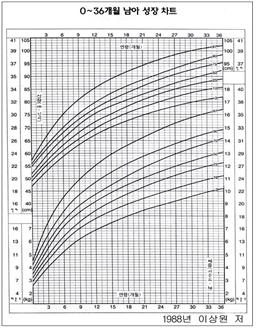
그림 3-15. 생후 0~36개월 된 한국 남 신생아들과 남 영유아들의 성장차트와 백분위수.
Copyright ⓒ 2012 John Sangwon Lee, MD., FAAP
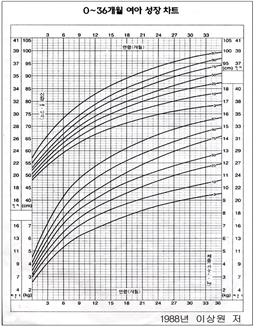
그림 3-16. 생후 0~36개월 된 한국 여 신생아들과 여 영유아들의 성장차트와 백분위수.
Copyright ⓒ 2012 John Sangwon Lee, MD., FAAP
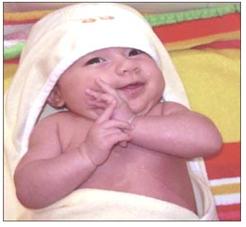
사진 3-17. 2개월 반 된 영아의 행복한 하루.
Copyright ⓒ 2012 John Sangwon Lee, MD., FAAP

사진 3-18. 2개월 반 된 영아의 행복한 하루.
Copyright ⓒ 2012 John Sangwon Lee, MD., FAAP
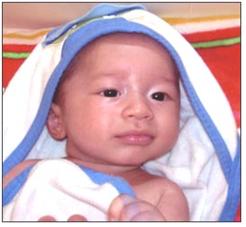
사진 3-19. 2개월 반 된 영아의 행복한 하루.
태어 날 때부터 기르기가 어려운 아이도 있다.
Copyright ⓒ 2012 John Sangwon Lee, MD., FAAP
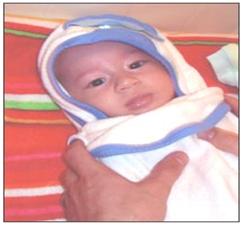
사진 3-20. 2개월 반 된 영아의 행복한 하루.
Copyright ⓒ 2012 John Sangwon Lee, MD., FAAP
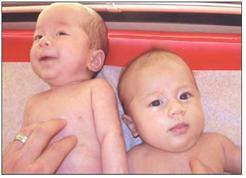
사진 3-21. 2개월 반 된 영아들의 행복한 하루.
Copyright ⓒ 2012 John Sangwon Lee, MD., FAAP
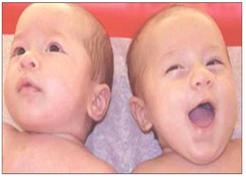
사진 3-22. 2개월 반 된 영아들의 행복한 하루.
Copyright ⓒ 2012 John Sangwon Lee, MD., FAAP
- 생후 2~4개월까지 대부분 영아들의 성장 속도는 아주 빠르다.
- 체중과 신장이 현저히 증가되고 있는 것을 눈으로 보고 느낄 수 있을 정도로 무럭무럭 자란다.
- 체중과 신장이 나날이 끊임없이 증가된다.
- 이 기간 동안 체중은 하루 평균 15~20g 증가된다.
- 소아청소년과에서 정기 건강검진을 받을 때 체중과 신장을 잰다.
- 체중 치와 신장 치는 성장차트 체중·신장 백분위선에서 몇 퍼센타일인지 알아본다.
- 영아의 체중과 신장이 성장차트 체중·신장 백분위선을 따라 예정대로 전과 같이 계속 증가되면서 정상적으로 잘 자라고 있는지 알아본다.
| 소아 청소년 예측 체중 신장 계산 공식 |
소아청소년 아이들의 예측 체중 증가
|
소아청소년 아이들의 예측 평균 체중 계산 공식
|
소아청소년 아이들의 예측 평균 신장 계산 공식
|
소아청소년 아이들의 예측 평균 신장 계산 공식
|
| 생후 2∼4개월 영아들의 발육 |
1. 생후 2∼4개월 영아들의 신체 발육
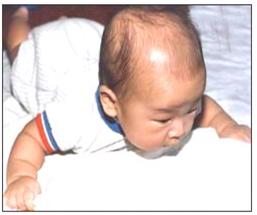
사진 3-23. 생후 2~3개월 영아들은 머리를 바닥에서 들어 올릴 수 있고 기어가려는 듯이 몸을 앞으로 움직일 수 있다.
Copyright ⓒ 2012 John Sangwon Lee, MD, FAAP
- 생후 2~4개월까지 대부분의 영아들은 눈앞에서 2~3m 정도 떨어져 있는 엄마 아빠의 얼굴은 바라볼 수 있다.
- 등을 바닥에 대고 반듯이 누워 있는 영아의 두 손을 잡고 영아의 전신을 바닥에서 천천히 일으켜 세워 앉힐 때 대부분의 영아들은 목에 힘을 많이 주고 목이 전보다 덜 흔들거리고 목을 꼿꼿이 세울 수 있다.
- 배를 깔고 바닥에 누워있는 자세에서 얼굴과 머리를 바닥에서 조금 들어 올릴 수 있다.
- 몸통을 전보다 더 순조롭게 움직일 수 있다.
- 때로는 마치 기어가려는 듯이 몸을 앞으로 움직일 수 있고 뒹굴 수 있다.
- 침대 위에 매단 장난감을 보고 손으로 잡으려고 그 쪽 방향으로 몸을 조금 움직일 수 있다.
2. 생후 2∼4개월 영아들의 손 발육
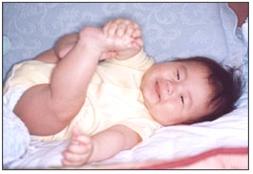
사진 3-24. 3개월 반 된 영아가 자기 발을 손으로 잡고 논다.
Copyright ⓒ 2012 John Sangwon Lee, MD., FAAP
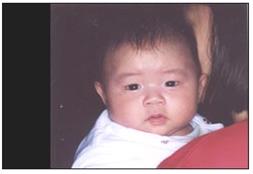
사진 3-25. 좋은 눈길 접촉을 가진 3개월 된 영아.
Copyright ⓒ 2012 John Sangwon Lee, MD., FAAP
- 손을 전보다 더 수의적으로 움직일 수 있다. 이때의 영아들은 자기 손을 빨기 좋아한다.
- 한쪽 손으로 자신의 다른 쪽 손을 잡을 수 있다.
- 자신이 한 손으로 다른 손을 잡을 수 있다.
- 그 잡은 손을 들여다 볼 수 있다.
- 손으로 발을 잡기도 한다.
3. 생후 2∼4개월 영아들의 언어 발육
- 이 시기의 영아들은 자기 자신의 고유한 소리나 울음 말(특이한 음색, 톤과 음량으로)로 엄마아빠보고 자기를 돌보아 달라고 요구할 수 있다.
- 엄마아빠나 다른 사람이 친밀한 목소리로 말하면 알아듣는 것같이 자기도 크게 소리 내어 아기 말로 대꾸하고 웃고 좋아한다.
- 어디가 아플 때, 배고플 때, 기분이 상할 때, 기저귀가 젖었을 때는 울어서 엄마아빠에게 그 사실을 알린다.
- 그때그때 아기의 울음 말소리의 음색과 음량이 상황에 따라 조금씩 다른 것을 엄마아빠도 인지할 수 있다.
4. 생후 2∼4개월 영아들의 사회성 발육
- 배가 고플 때는 먹고 싶다고 울어서, 또는 몸짓 말로 표시해서 엄마아빠에게 알린다.
- 즐거울 때는 웃고, 마음 아플 때는 불안해한다.
- 엄마아빠의 친밀한 목소리가 나는 방향으로 머리와 고개를 돌릴 수 있다.
- 아프거나 기저귀에 싼 오줌똥으로 불편하면 보채기도 하고, 울음 말과 몸짓 말로 엄마아빠에게 도와 달라고 청할 수 있다.
- 자기의 주위에 있는 것에 흥미를 갖기 시작한다.
- “생후 1개월~6세의 영유아들의 더 자세한 발육 이정표” 참조.[부모도 반의사가 되어야 한다-소아가정간호백과]-제 18권 소아청소년 이비인후 질환 -난청과 귀머거리 참조.
| 생후 2∼4개월 영아들의 영양 |
1. 모유수유
- 모유를 1회분 150~180cc 정도를, 매 3~4시간마다 하루 6~8회 정도 먹인다.
- 이때의 어떤 영아들은 밤에 4~6시간 동안 깨지 않고 계속 내쳐 자기도 한다.
- 밤에 4~6시간 동안 깨지 않고 곤히 계속 잠자는 영아를 일부러 깨워 젖이나 인공영양을 꼭 먹일 필요가 없다.
- 모유를 먹는 영아에게 비타민 A, C, D 종합 비타민제로 매일 또는 이틀 간격으로 처방에 따라 주어도 된다. 철분제는 특별한 이유 없이 이 시기에 먹일 필요가 없다.
2. 인공영양
-
1회분 인공영양 150~180cc(5~6온스)를 1일 5~6회 정도 먹는다.
표 3-6. 주령이나 월령에 따라 영아가 한 번에 먹을 수 있는 인공영양의 평균 용량.
|
1회 평균용량
영아의 나이 |
1회 먹을 수 있는 평균 용량(cc) |
| 생후1~2 주 | 60~90 |
| 생후 3주~2개월 | 120~150 |
| 생후 2~3개월 | 150~180 |
| 생후 3~4개월 | 180~210 |
| 생후 5~12 개월 | 210~240 |
표 3-7. 첫 돌 이전까지 영아의 월령에 따라 1일 인공 영양을 먹을 수 있는 평균 횟수
|
평균횟수
영아의 나이 |
1 일 먹을 수 있는 평균 횟수 |
| 갓 태어나서 부터~1주일 | 6~10회 |
| 생후 1주~1개월 | 6~8회 |
| 생후 1~3개월 | 5~6회 |
| 생후 3~7개월 | 4~5회 |
| 생후 4~9 개월 | 3~4회 |
| 생후 8~12개월 | 3회 |
참고문헌:1,2,3,4
표 정상 조건하에서 나이에 따른 소아 수분 필요 용량
|
평균 체중, 수분 용량
나이 |
평균 체중(kg) | 1일 총 수분 용량(cc) | 1일 수분 필요 용량(cc) (체중 매kg당) |
| 생후 3일 | 3.0 | 250-300 | 80-100 |
| 생후 10일 | 3.2 | 400-500 | 125-150 |
| 생후 3개월 | 5.4 | 750-850 | 140-160 |
| 생후 6개월 | 7.3 | 950-1100 | 130-155 |
| 생후 9개월 | 8.6 | 1,100-1,250 | 125-145 |
| 1세 | 9.5 | 1,150-1,300 | 120-135 |
| 2세 | 11.8 | 1,350-1,500 | 115-125 |
| 4세 | 16.2 | 1,600-1,800 | 100-110 |
| 6세 | 20.0 | 1,800-2,000 | 90-100 |
| 10세 | 28.7 | 2,000-2,500 | 70-85 |
| 14세 | 45.0 | 2,200-2,700 | 50-60 |
| 18세 | 54.0 | 2,200-2,700 | 40-50 |
3. 생후 2∼4개월 영아들의 이유식
- 생후 4개월 이전에 이유식을 먹이기에는 아직 이르다.
- 생후 4개월이 되기 전에는 가능한 한 모유만 먹이든지 인공영양만 먹여야 한다.
4. 생후 2∼4개월 영아들의 물과 수분
- 날씨가 몹시 덥거나 실내 온도가 높아 땀을 많이 흘리거나 탈수된 것 같으면 끓여 식힌 맹물을 숟가락으로 떠먹이든지 우유병으로 가끔 먹일 수 있다.
- 변비가 있거나 변비가 생길까 걱정되면 끓여 식힌 맹물 30~60cc를 하루 한두 번 먹일 수 있다.
| 생후 2∼4개월 영아들의 양호 |
- 생후 2개월에 정기 건강검진을 소아청소년과나 소아청소년과 클리닉에서 받아야 한다.
- 정기 건강검진을 받을 때 체중, 신장, 머리둘레 등을 재고 정상적으로 성장 발육하나 알아본다.
- 양육에 관한 제반 사항에 관해 소아청소년과 의사와 상담한다.
- 체중 치와 신장 치를 성장차트 백분위선에 그려 본다.
- 체중 치와 신장 치는 성장차트 체중·신장 백분위선에서 몇 퍼센타일 인지 알아본다.
- 생후 2개월 건강검진을 받은 후 아기가 전반적으로 건강하고 잘 성장 발육하고 전에 DTaP, 불활성 소아마비(IPV), 히브(Hib), 로타(RV)와 폐렴 연쇄상 구균 감염병의 백신(PCV)으로 1차 예방접종을 전에 접종받지 안 했으면 접종 받는다.
- 2차 예방접종을 전에 접종받지 안 했으면 2차 b형 간염 백신 예방접종(HepB)을 접종 받는다.
- 다음 정기 건강검진은 생후 3개월이나 4개월경에 받는다.
- 이제 까지 2차 DTaP, 2차 불활성 소아마비(IPV), 2차 히브(Hib), 2차 폐렴 연쇄상 구균 감염병 예방 접종백신(PCV)과 로타(RV)백신으로 2차 접종을 받지 안했으면 생후 4개월경 정기 건강 검진을 받을 때 2차 접종을 받는다.
- 영아를 데리고 승용차로 어디를 갈 때는 영아용 승용차 안전의자에 앉혀야 한다.
- 낙상 사고가 생기지 않게 높은 곳에 영아를 앉히거나 뉘지 말아야 한다.
- 뜨거운 커피나 국물 등에 화상 사고가 생기지 않게 특별히 주의해야 한다.
- 각종 안전사고가 나지 않게 예방한다.
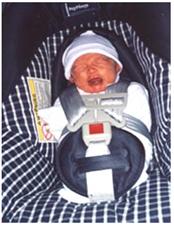
사진 3-26. 승용차를 탈 때는 법적 규격에 맞는 승용차 안전 의자에 앉힌다.
Copyright ⓒ 2012 John Sangwon Lee, MD., FAAP
| 생후 2∼4개월 영아들의 정상 수면 패턴 |
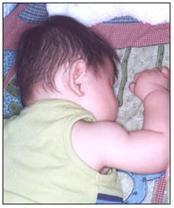
사진 3-27. 생후 6개월 이전 영아들을 재울 때 등을 바닥에 대고 재운다.
Copyright ⓒ 2012 John Sangwon Lee, MD., FAAP
- 생후 6주부터 수면시간과 깨어 있는 시간주기 즉 24시간 밤낮주기가 어느 정도 구분되기 시작한다.
- 생후 4개월(16주) 대부분의 영아들이 밤과 낮 시간 주기에 맞춰 밤에는 더 자고 낮에는 더 오랫동안 깨어 있는 것이 보통이다.
- 즉 “24시간 밤낮 리듬(24시간 밤낮 주기)에 따라 자고 깨는 수면 패턴이 더 확실 해 진다.
- 각 영아에 따라 1일 총 수면 시간이 정상적으로 조금씩 다르다.
- 생후 첫 8~16주 영아들의 대부분은 하루 평균 15∼20시간 잔다.
- 생후 2개월 영아들의 일부는 밤에 5~6시간 이상 동안 깨지 않고 계속 자기도 하고, 대부분은 매 2~3시간마다 깨서 모유나 인공영양을 먹기 원한다.
- 생후 2~3개월 영아들의 대부분은 밤에 더 많이 자고 낮에는 더 많이 깨어 있는 수면 패턴 즉 24시간 밤낮 주기가 전보다 좀 더 현저해진다.
- 생후 4개월 된 영아들은 깨어 있는 최장 시간은 2.5~3.5시간이고 한 번 최장 수면시간은 8.5시간이다.
- 이 시기의 영아가 밤에 자다가 깨면 조용히 살펴봐야한다.
- 소변만 쌌으면 기저귀를 곧 갈아줄 필요가 없다.
- 먹일 때가 됐으면 먹이고 트림시키는 것 이외 영아를 필요 이상 다루어서는 안 된다.
- 영아가 활짝 깨어 있어도 영아가 편안하고 아무 이상이 없으면 아기 크립에 누워 자게 한다.
- 위에서 설명했지만 소변만 싼 기저귀는 너무 많이 젖지 않는 한 매번 싼 후 꼭 갈아 줄 필요가 없다.
- 적어도 생후 6~8주 이후부터 잠재우기 전 “잠자기 전 일정한 의식”으로 수면 훈련을 통상적으로 시키면 영아들은 더 안정되고 편안한감을 느끼고 쉽게 잠들 수 있고 더 잘 잘 수 있다.
- 예를 들면, 잠재우기 전에 목욕시키고, 잠옷으로 갈아입히고, 이야기책을 읽어주고, 자장가를 불러주고, 굿 나이트라고 말하고, 아기의 침실에서 나오는 식으로 “잠자기 전 일정한 의식”으로 잠 훈련을 시킨다.
- 물론 월령이나 나이에 다라 적절하게 “잠자기 전 일정한 의식”을 변경시킬 수 있다.
- 이런 의식으로 잠들기 전, 잠자기에 좋은 분위기를 조성해 주면 쉽게 잠들 수 있다.
- 이런 의식을 매일 거의 같은 시간에 같은 식으로 영유아들에게 해주면 잠 잘 때가 온 줄을 알고 영유아 스스로 잠들고 잘 잘 수 있다. [부모도 반의사가 되어야 한다-소아가정간호백과]-제 22권 아들 딸 이렇게 사랑해 키우세요-잠 참조.
| 생후 2~6개월 영아들의 수면 체위 |
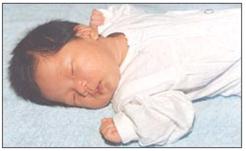
사진 3-28. 등을 바닥에 대고 잰다.
Copyright ⓒ 2012 John Sangwon Lee, MD., FAAP
- 신생아들이나 영아들을 잠재울 때 얼굴은 천장을 향하고 등은 바닥에 대고 반듯이 눕혀 재우는 수면체위를 권장한다.
- 등을 바닥에 대고 재우면 아기가 덮은 담요로 코나 입 등의 기도가 막혀 질식될 위험성이 적고 영아 돌연사 발생률이 적다.
- “언제까지 영아들의 등을 바닥에 대고 재워야 좋으냐?”라는 질문에 답변을 확실히 말할 수 없다.
- 그러나 영아들이 엎치고 뒤칠 때까지 그들을 재울 때 등을 바닥에 대고 재우는 것을 권장한다.
- 그렇지만 등을 바닥에 대고 자던 아기가 먹었던 모유나 인공영양을 토하거나 넘길 때 구토물이 기도 속으로 흡인될 가능성은 더 많다.
- 기도 속으로 흡인된 구토 물로 기도 속이 막혀 질식될 수 있고, 흡인성 폐렴 등이 생길 수 있다.
- 그와 반대로, 얼굴을 바닥으로 향하고 배를 바닥에 대어 엎어 자는 신생아들이나 영아들이 토한 구토물이 기도 속으로 흡인될 위험성은 적지만 담요 등으로 코와 입 등 기도가 막힐 가능성이 더 많고 그로 인해 호흡곤란이 생길 수 있고 질식될 수 있고 영아 돌연사가 생길 가능성이 더 많다.
- 신생아들이나 영아들을 재울 때 옆으로 눕혀 재우는 것이 이상적인 수면 체위인 것 같지만 그 수면체위를 계속 취하고 오랫동안 계속 자게 하는 것도 그리 쉽지 않다.
- 모유나 인공영양, 또는 이유식을 먹인 바로 후 신생아들이나 영아들을 오른쪽 옆으로 눕혀 재우는 것이 가장 이상적이라 생각할 수 있지만 그 체위를 계속 유지하면서 오랫동안 잠잘 수 없기 때문에 그것도 적절하고 권장할 만한 수면 체위가 아니다.
- 신생아들이나 영유아들에게 베개를 베어 눕혀 재우면 베개로 신생아나 영아의 코나 입 등이 막혀 호흡곤란이 생길 수 있고 질식될 수 있다.
- 그러나 부드럽고 보기 좋은 인형이나 곰 인형 등 일시적 대상을 아기 크립 한쪽에 놓아 둘 수는 있다. [부모도 반의사가 되어야 한다-소아가정간호 백과]- 제 22권 아들 딸 이렇게 사랑해 키우세오- 신생아들 영유아들의 정상 수면 패턴, 수면 훈련과 그 문제를 참조.
| 다음 경우, 영유아 발육 지연을 의심해 봐야한다. |
- 생후 2~3개월에 엄마를 보고 아주 좋아하지 않고 무관심하거나
- 생후 3개월에 다른 사람을 보고 반가이 웃지 않거나
- 생후 3개월 반에 파악 반사가 아직 나타나거나
- 생후 4개월 반에 몸통을 끌어서 앉힐 때 꼿꼿이 앉을 수 없거나
- 생후 4~5개월에 소리 나는 장난감을 손으로 쥘 수 없거나
- 생후 5개월에 엎치지 못하거나
- 생후 5~6개월에 아기 말을 할 수 없거나
- 생후 6~7개월에 손에 들고 있던 장난감을 놓치고 그것을 찾을 생각을 통 하지 않거나
- 생후 6~8개월에 놀 때 소리 내어 웃을 수 없거나
- 생후 7~8개월에 붙들어 주지 않으면 혼자 앉을 수 없거나
- 생후 7개월에 한 손으로 장난감을 잡을 수 없거나
- 생후 8~9개월에 ‘다’, ‘바’ 소리, 또는 그 외 그와 비슷한 아기 소리를 낼 수 없거나, 피카브 놀이에 전혀 흥미 없거나
- 생후 9~10개월에 몸통을 잡고 세울 때 설 수 없거나
- 생후 10~11개월에 손가락으로 집을 수 없거나, ‘다다’ 또는 ‘바바’ 소리를 낼 수 없거나
- 생후 12개월에 감춘 장난감을 찾으려고 노력하지 않거나, 울 때 달래도 그치지 않거나, 몸을 붙들 때 전신이 빳빳하거나
- 생후 15개월에 걸을 수 없거나,
- 장난감을 장난감 통속에 넣고 꺼낼 수 없거나,
- 의미 있는 3개 이상 단어를 써서 말할 줄 모르거나
- 생후 15~18개월에 인과 관계가 있는 게임에 흥미가 전혀 없으면 비정상적일 수 있다.
- 발육이 늦거나 발육지연이 있는 것 같으면 의사와 상담한다.
|
다음은“인공영양(포뮬라/포물라)양이 줄었어요”에 관한 인터넷 소아청소년 건강상담 질의응답의 예 입니다. |
Q&A. 인공영양(포뮬라/포물라)양이 줄었어요
Q.
3 개월 된 사내아이인데 1달 전부터 우유를 잘 안 먹습니다.
2시간에 100정도 먹었는데 3시간이 되어도 잘 안 먹을 때가 있습니다.
일시적인 것인지 아니면 무슨 문제가 생긴 것인지 궁금합니다.
A.
- 우석님께
- 안녕하세요. 좋은 질문을 해주셔 감사합니다. 영아들은 각 영아의 크기, 체질, 먹성, 그날그날 때로는 먹는 시간 등에 따라 먹는 양이 다소 변할 수 있습니다.
- 또 나이가 같은 또래 영아들 중 덩치가 더 큰 영아들은 그들 보다 덩치가 작은 영아들보다 더 많이 먹는 것이 보통입니다.
- 출생 시 체중, 생후 1개월의 체중, 2~3개월의 체중을 얼마인지 알면 아기의 체중이 어떤 성장 속도로 증가되는지 알 수 있고 아기가 조제분유를 어는 정도 먹어야 적절한지 답변 드리기가 좋습니다.
- 아시겠지만 우유에는 생우유, 탈지우유, 전 우유 등 여러 종류가 있고 어떤 종류의 우유는 생후 1세 전 영아들에게 먹여서는 안 됩니다.
- 말씀하시는 우유는 인공영양이나 조제분유를 의미하시는 주로 알고.
- 생후 3개월 된 영아들은 1회분 90~150cc 인공영양을 매 3~4시간 간격으로 먹는 것이 보통입니다.
- 이런 식으로 먹으면 하루 필요로 하는 영양분과 총 수분 량과 칼로리 량을 충분히 섭취할 수 있습니다.(표 3-6, 37 참조)
- 그 나이 영아가 1회 분 90cc 이하로 인공영양을 먹으면 신체 어디에 이상이 있는지 그 인공영양이 체질에 맡지 않든지 인공영양을 잘못 조제해서 먹이든지 또는 다른 이유가 있을 수 있습니다.
- 아기의 소아청소년과에서 검진 진단 치료를 받으시기를 바랍니다.
- [부모도 반의사가 되어야 한다–소아가정간호 백과]-제 5권 인공영양, 이유식, 비타민, 미네랄, 지방, 단백질 참조. 해당 연령 성장 발육을 참조하시기 바랍니다.
- 질문이 더 있으면 또 방문하세요. 감사합니다. 이상원 드림
|
다음은 “아기의 성장 발육, 인공영양”에 관한 인터넷 소아청소년 건강상담 질의응답의 예 입니다. |
Q&A. 아기의 성장 발육, 인공영양
Q.
- 전에 신생아가 열이나 혈액배양 검사 등을 받았다고 질문했던 엄마에요.
- 벌써 백일이 다 됐습니다. 퇴원하고 별 이상 없이 잘 커왔는데 너무 작은 것 같아 걱정입니다.
- 우유는 120-140정도 하루5-6번 정도 먹고 변은 하루 한 번 정도 보긴 하는데. 몸무게가 2틀 전에 6.4kg입니다. 태어날 때는 3.34kg이었구요. 백일정도 되면 태어날 때의 2의 몸무게가 된다고 하던데 아기가 너무 안 먹는 것 같아요. 평균 몸무게에 많이 미달되는 것 같아 걱정입니다.
- 그리고 거의 녹변을 봅니다. 담당 의사선생님은 녹변에 대해 별로 걱정을 안 하시던데 아이들 마다 조금씩의 차이는 있다고 하지만 남자아이인데 너무 안 먹는 건 아닌지. 보는 사람들 마다 작고 여리다고해서 속상하기만 하네요. 어떤 병이 있는 건 아니겠죠?
- 옹알이는 50일 정도부터하고 잘 웃고 잘 자고 요즘 뒤집기도 가끔 합니다.
- 잘 안 먹는 것 빼고는 별 이상은 없는 듯한데. 많이 속상합니다.
A.
- 허 님
- 안녕하세요. 또 좋은 질문해 주셔서 감사합니다.
- 자녀의 나이, 성별, 과거 병력, 가족 병력, 진찰소견, 임상검사 등의 정보를 많이 알수록 답변을 드리는데 도움이 됩니다. 주신 정보를 참작해서 답변을 드리겠습니다.
- 전체적으로 잘 크고 정상적으로 발육하고 있는 것 같습니다.
- 제가 만든 한국 소아성장차트에 의하면 아기의 출생 시 체중은 25퍼센타일 정도이었고 현재는 75퍼센타일 정도입니다.
- 생 후 4~5개월이 되면 출생 시 체중의 배가 되는 것이 정상인데 생후 3개월의 체중이 이미 배가 넘었으니 아주 잘 성장하는 것입니다.
- 신장 치를 주시지 않았기 때문에 얼마나 뚱뚱한지 빼빼한지를 말씀드릴 수 없습니다.
- 소아기 때 비만했던 아이들의 85%가 성인 비만으로 이어집니다.
- 소아청소년들이 비만하지 않도록 예방하는 것이 상당히 중요합니다.
- 아기가 120∼140cc x 5∼6= 600∼700cc 내지 720∼840cc의 수분과 400∼560의 칼로리 량을 하루에 섭취하고 있습니다.
- 권장하는 1일 수분 섭취량은 140∼160cc/kg=836∼956cc이고 칼로리 량은 100∼120 x6.4=640∼768 칼로리입니다.
- 계산상 권장량 보다 조금 적게 먹고 있습니다. (표 3-6, 37 참조) 참고로 생후 4개월까지 이유식을 주지 않는 것이 좋습니다.
- 이렇게 먹여보시지요.
- 1회분 120~140cc 인공영양을 한 번에 다 먹으면 그 다음 번 인공영양을 먹일 때는 바로 전에 먹였던 1회분 양(이 경우에는 120~140cc)에다 30cc정도를 더 가해서 먹이십시오.
- 1회분 용량을 먹고 남은 것은 버리십시오.
- 이런 식으로 인공영양을 먹이면 한 번에 먹는 1회분 양을 대략 알아낼 수 있습니다.
- 한 번에 많은 용량의 인공영양을 먹으면 하루 먹는 총 횟수가 줄어드는 것이 보통입니다.
- 어떤 영아들은 1회분 양을 매번 추가로 증가시킨 인공영양의 양을 다 먹어 비만해 질 수 있습니다.
- 참고하시기 바랍니다.
- 아기의 체중이 신장에 비해 과체중인데도 더 많이 먹이면 비만해 질 수 있습니다.
- 소아청소년과에서 검진을 받으시고 상담해서 결정하시기 바랍니다.
- 해당 연령. [부모도 반의사가 되어야 한다– 소아가정간호 백과]-제 5권 인공영양, 이유식, 비타민, 미네랄, 지방, 단백질–한 번에 먹을 수 있는 인공영양의 양과 하루에 먹을 수 있는 인공영양의 총량. 제 14권 소아청소년 내분비, 유전, 염색체, 대사, 희귀병 –비만증 등을 참조하시기 바랍니다. 질문이 더 있으시면 다시 연락 주세요. 감사합니다. 이상원 드림
|
다음은“잠잘 때의 수면체위, 업어 재우기”에 관한 인터넷 소아청소년 건강상담 질의응답의 예 입니다. |
Q&A. 잠잘 때의 수면체위, 업어 재우기
Q.
- 안녕하세요. 엎어서 재우면 머리통이 이뻐지고 발달에도 좋다고 하는데요. 이제 80일가량 넘었구요. 여아입니다. 엎어놓으면 머리를 들기도 하구요. 이쪽저쪽으로 바꾸기도 합니다.
- 엎어서 키우기에 적당한 시기와 우유를 먹고 난 후에는 얼마나 있다가 엎어놔야 하는지요?
- 아직 밤에 엎어서 재우기엔 좀 불안하지요? 조언 부탁드립니다.
- A.
- 초보 맘
- 안녕하세요. 좋은 질문을 해주셔서 감사합니다.
- 자녀의 나이, 성별, 과거 병력, 가족 병력, 진찰소견, 임상검사 등의 정보를 많이 알수록 답변을 드리는데 도움이 됩니다. 주신 정보를 토대로 답변 드리겠습니다.
- 등을 대고 자처 재우면 토할 때 구투물이 기도 속으로 흡인돼서 흡인성 폐렴이나 기도 폐쇄 등의 문제가 생기기 쉬우나 엎어 재우면 영아들이 미약해서 머리와 얼굴은 이쪽저쪽으로 잘 돌릴 수 없어 숨이 막히는 문제 등이 더 잘 생길 수 있습니다.
- 10여 년 전까지만 해도 미국 소아청소년과학회는 신생아들이나 영아들을 재울 때 앞가슴과 배를 방바닥에나 침대위에 대어 엎어 재워도 좋다고 권장했으나 이젠 신생아들과 영아들을 가능한 한 등을 바닥에 대고 재우도록 권장합니다.
- 연구에 의하면 등을 바닥에 대고 재우면 영아 돌연사가 생기는 확률이 적어집니다.
- 엎어서 재우면 머리통이 더 예뻐진다는 연구도 없고 뇌 발달에 더 좋다는 연구 통계도 없습니다.
- 정확하게 생후 몇 개월 때부터 엎어 재워도 괜찮은지, 또 우유(?)를 먹인 후 얼마 후에 엎어 재워야 좋은지 연구 문헌을 읽어 본적도 없습니다.
- 소아청소년과에서 정기 건강검진을 받으시고 이 문제에 대해서 건강 상담을 하시기 바랍니다. p.00 해당 연령, 성장 발육 p.00 생후 1개월~6세 아이들의 발육 이정표 등을 참조하시기 바랍니다.
- [부모도 반의사가 되어야 한다–소아가정간호백과]-제 22권 아들 딸 이렇게 키우시오세요–잠을 참고하십시오.
- 질문이 더 있으면 다시 연락해 주시기 바랍니다. 감사합니다. 이상원 드림
|
다음은“ 장염, BCG결핵 백신 부작용, 혼합수유, 자녀양육”에 관한 인터넷 소아청소년 건강상담 질의응답의 예 입니다. |
Q&A. 장염, BCG결핵 백신 부작용, 혼합 수유, 자녀 양육
Q.
- 안녕하세요. 첫아기를 출산하고 정말 아기가 잔 병치fp를 많이 하는 거 같아서요.
- 지금두 두 번째 장염을 앓구 있답니다.
- 첫아이라 아는 것두 없구 그래서 반갑게두 이 싸이트를 알게 되어서^^
- 태어난 지는 오늘 77일째 됩니다. 혼합수유하거든요.
- 지금 장염을 쫌 심하게 하는 거 같아서요.
- 의사 말론 음식에서 오는 장염같다구 하더라구요.
- (부득하게 제가 직접 아기를 데리구 병원을 갈 형편이 아니어서 친정엄마 직접 간답니다.) 엄마인 제가 잘 못 먹어서 아님 분유에서.
- 제가 분유를 두어번 바꾼 적은 있거든요. 이것두 장염에 원인가요??
- 약을 타와서(약은 가루약을 주더라구요) 약도 먹이구 설사분유를 먹이구 있기는 한데 전혀 잡힐 생각을 안해서요. 계속 병원을 다니면서 약을 타서 먹여야 할지.
- 병원에서 탈수증세가 오구 그럼 병원에 입원해야 한다구 하더라구요.
- (장염때 설사분유 먹는데 모유를 먹이어두 될까요? 장염전에도 혼합수유 했지만요~)
- 근데 설사분유를 쫌 찐하게 타서 먹여두 될가요?
- 그리구 뭐 민간요법은 없을까요?
- 쑥을 즙을 내어서. 아기는 설탕을 타서 먹구 엄마는 그냥 먹구.
- 그럼서 모유수유를 하구 또 설사분유도 먹구.
- 그럼 좀 도움이 될까요?? (친엄마가 쑥이 좋다구 해서요)
- 그리구 또 하나 BCG 맞은 뒤 겨드랑이에 멍울이 생겼답니다.
- 의사샘 말론 일단 지켜보자구 하더라구요.
- 그리구 결핵반응검사를 해보구 이상없으면 조직검사를.
- 근데 결핵성임파선 뭐 같다구 하더라구요. 심해지면 수술까지 해야 한다구 하던데.
- 현재 울 아기 겨드랑이는 그냥 딱딱한체. 처음에 조금씩 켜지는 거 같더라구요.
- 켜진 상태에서 지금은 멈춰 있는 거 같기두 하구요 조금씩 커지는 거 같기두 하구요.
- (너무 자주 만져봐서 모르겠어요) 크기는 어른 손가락 한 마디정도(?) 그냥 지켜봐두 될까요?
- 또 질문 하나만 더 할게요.
- 아기가 태어서 한 달 있다가 정기검진검사를 받으라 보니깐 되어 있던데 어떤 걸 말하는 건지요?? 예방접종인지 아님 피검사 뭐 그런 건가요?? 초보엄마라 넘넘 답답해요.
A.
초보 엄마께
안녕하세요. 질문해 주셔서 감사합니다. 좋은 질문입니다. 자녀의 나이, 성별, 과거 병력, 가족 병력, 진찰소견, 임상검사 등의 정보를 많이 알수록 답변을 드리는데 도움이 됩니다.
주신 정보를 토대로 답변 드리겠습니다.
Q.
- 혼합 수유하거든요. 지금 장염을 쫌 심하게 하는 거 같아서요.
- 의사 말론 음식에서 오는 장염 같다구 하더라구요. (부득하게 제가 직접 아기를 데리구 병원을 갈 형편이 아니어서 친정엄마 직접 간답니다.) 엄마인 제가 잘 못 먹어서 아님 분유에서. 제가 분유를 두어번 바꾼 적은 있거든요. 이것두 장염에 원인가요??
A.
- 제가 이런 홈페이지를 통해 답변 드리면 질문하신 엄마님께서도 읽어보시고 다른 많은 분들도 읽어봅니다.
- 그러니 저의 책임이 얼마나 크겠습니까.
- 부모님들뿐만 아니라 많은 소아청소년과 의사들 또 장차 의사가 될 의과대학 학생들도 제 홈페이지를 방문하실 것입니다.
- 왜 이런 말씀을 드리는지 이해하실 줄 믿습니다.
- 저의 의학지식이 모자라서 좋은 답변을 드릴 수 없는 때도 있는 줄 압니다.
- 그러나 저는 저의 전력을 다해서 때로는 참고서를 찾아보고 답변 드리는 것입니다.
- 저의 답변을 개인적인 입장에서 받아들이지 마시고 공적 입장에서 보시기 바랍니다.
- 혼합수유를 하신다고 말씀 했는데 건강한 산모는 650~850cc 정도 모유를 하루에 분비할 수 있습니다.
- 모유는 아기에게 가장 좋은 음식물이고 최상으로 좋은 영양가가 있는 음식물입니다.
- [부모도 반의사가 되어야 한다–소아가정간호 백과]-제 4권 모유, 모유수유, 이유를 읽어보시고 모유만 수유하시도록 노력하시면 잔병이 거의 다 없어질 수 있을 것입니다.
- 분유를 더 이상 먹이지 마시고 혼합수유를 하지 마십시오.
- 저는 혼합수유란 단어 자체를 아주 싫어합니다. 그래서 “혼합수유”를 “혼동수유”라고 말하고 싶습니다.
- 그 이유는 아기들이 혼합수유로 많이 고생하고 있는 것으로 알기 때문입니다.
- 많이 자시고 정신적으로 육체적으로 편히 쉬고 모유수유만 하시면 아기는 모유에서 필요한 충분한 영양분, 수분, 비타민, 칼로리 등을 섭취할 수 있고
- 거기다가 엄마로부터 신체적 접촉 사랑, 눈길 접촉 사랑, 집중적 관심적 사랑 등을 더 온전하게 받을 수 있습니다.
- 분유로 인한 우유 단백 알레르기성 위장염에 걸리지 않을 수 있습니다.
- 가능한 한 소아청소년과에서 감진 받을 때 아기가 가진 증상 징후 등을 적은 메모지를 가지고 가십시오.
- 엄마 자신이 아기를 데리고 소아청소년과에 가면 더 좋을 것 입니다.
- 그 이유는 많은 설명이 필요 없이 아실 것입니다.
- 의사가 아기의 엄마아빠에게 직접 말씀할 것이 따로 있고 부모 아닌 제 삼자인 친정어머니에게 말씀 드릴 것이 따로 있습니다.
- 그때그때에 부모가 의사에게 문의할 것이 있기 때문에 부모가 직접 네 자녀 내 아기를 직접
- 소아청소년과로 데리고 가야 합니다.
- 아기는 엄마 아빠의 아기지요.
- 참고하시라고 말씀드립니다.
- 많은 경우, 미국에서는 친정어머님이 신생아를 소아청소년과에 엄마아빠 대신 데리고 오시면 아기의 친부모로부터 진료 치료를 받는에 필요한 서면 허락을 받아야만 어떤 종류의 진료 치료를 시작할 수 있습니다.
Q
- 약을 타와서(약은 가루약을 주더라구요)약도 먹이구.. 설사분유를 먹이구 있기는 한데 전혀 잡힐 생각을 안해서요. 계속 병원을 다니면서 약을 타서 먹여야 할지.
- 병원에서 탈수증세가 오구 그럼 병원에 입원해야 한다구 하더라구요.
- (장염때 설사분유 먹는데 모유를 먹여두 될까요? 장염전에도 혼합수유 했지만요~)
- 근데 설사분유를 쫌 찐하게 타서 먹여두 될까요?
- A.
- 죄송스럽습니다.
- 여러 가지 질문에 답변을 다 드리기가 어렵습니다.
- 장염이 있을 때 언제든지 원인을 확실히 알 수는 없지만 무슨 원인으로 장염이 생겼는지 적어도 어느 정도 추정으로 진단하고 그 원인에 따라 장염을 치료 하는 것입니다.
- 가령 분유에 들어 있는 우유 단백이나 유당 등으로 설사를 할 때는 분유를 먹이지 않으면 설사가 멎을 것이고 바이러스성 위장염으로 설사를 할 때는 거의 대부분이 시간이 가면 자연적으로 나을 수 있을 것이고 박테리아 위장염이 있을 때는 박테리아를 죽일 수 있는 항생제로 치료해야 박테리아 위장염이 치료되는 것이 보통입니다.
Q.
- 그리구 뭐 민간요법은 없을까요?
- 쑥을 즙을 내어서 아기는 설탕을 타서 먹구 엄마는 그냥 먹구. 그럼서 모유수유를 하구 또 설사분유도 먹구. 그럼 좀 도움이 될까요?? (친엄마가 쑥이 좋다구 해서요)
A.
- 달나라에 계수나무가 있다고 생각했던 그 시절도 오래 전에 지나갔고 에이즈는 바이러스에 의해서 생기고 사스(SARS)라는 병은 코로나 바이러스에 의해서 생기고 마마병이 이 세상에서
- 없어지고 소아마비가 거의 없어지고 있는 세상에서 우리들은 살고 있습니다. 사이버세상에서 살고 있습니다.
- 쑥의 성분이 무엇이고 그 쑥을 2개월 된 아기에게 먹였을 때 간이나 뇌에 어떤 부작용이 생기는지 확실한 연구도 없고 내 소중한 아기에게 그런 쑥즙을 먹여서 치료를 해서는 안 된다고 생각됩니다.
- 죄송합니다.
- 조부모님께서 손자 손녀를 잘 도와주시려고 하시겠지만 그런 치료는 적절하지 않은 치료라고 생각됩니다.
- 아기는 독립된 한 개인입니다.
- 아기는 내 것이 아닙니다.
- 부모가 소유할 수 없습니다.
- 잘못 치료되어 아기의 생명이 위협 받을 때는 아동학대(소아학대)를 한 것으로 법정에 갈 수도 있습니다.
Q.
- 림프 그리구 또 하나 BCG 맞은 뒤 겨드랑이에 멍울이 생겼답니다. 의사샘 말론 일단 지켜보자구 하더라구요. 그리구 결핵반응검사를 해보구 이상 없으면 조직검사를. 근데 결핵성임파선 뭐 같다구 하더라구요. 심해지면 수술까지 해야 한다구 하던데.
- 현재 울 아기 겨드랑이는 그냥 딱딱한체. 처음에 조금씩 커지는 거 같더라구요.
- 켜진 상태에서 지금은 멈춰 있는 거 같기두 하구요 조금씩 커지는 거 같기두 하구요.
- (너무 자주 만져봐서 모르겠어요) 크기는 어른 손가락 한 마디정도(?) 그냥 지켜봐두 될까요?
A.
겨드랑이에 있는 림프절에 BCG 백신 결핵균이나 다른 종류의 박테리아 감염에 의해서 림프절염이 생긴 것 같습니다.
그 치료는 원인이 무엇인가 알아보고 원잉네 따라 또 그 림프절염의 경과에 따라 치료가 다릅니다. 그에 대해서 소아청소년과 의사로부터 계속 치료를 받으시기 바랍니다.
Q.
또 질문 하나만 더 할게요. 아기가 태어서 한달 있다가 정기검진검사를 받으라 보니깐 되어 있던데 어떤 걸 말하는 건지요?? 예방접종인지 아님 피검사 뭐 그런 건가요??
A.
- 이 질문은 잘 이해할 수 없지만 답변을 드리겠습니다.
- 한 근으로 치료하는 것보다 한 량으로 예방하는 것이 좋은 때가 많습니다.
- 아기의 체중이 정상적으로 느는지 키가 정상으로 크는지 먹는 모유나 인공영양의 양은 적절한지 모유수유를 해야 하는지 혼합수유를 해야 하는지 하루에 몇 번 정도 소변을 보아야 하는지 대변은 몇 번 정도 보아야 하는지 어떤 백신 예방접종이 필요한지 안전사고 예방은 어떤 것을 해 주어야 하는지 이러한 여러 성장 양육에 관한 것들을 단골 소아청소년과 의사로부터 체크 평가받고 단골 소아청소년과 의사와 부모가 상담을 하기 위해서 정기 건강검진을 받는 것입니다.
- 부모가 이런 것에 대해서 잘 모르면 더 자주 소아청소년과에 가야하고 더 많은 진료비를 내게 됩니다.
- 이런 이유로 미국에서는 고등학교에 들어갈 때까지 근 30만 불(약 3억원)을 들여야 한 자녀를 양육할 수 있다고 합니다.
- 그리고 대학을 졸업을 할 때까지 한 자녀양육비가 7~8십만 불이 든다고 합니다.
- 정말로 자녀를 양육한다는 것은 쉬운 일이 아닙니다.
- 죄송스럽습니다.
- 개인적인 입장에서 받으시지 말고 공적 입장에서 받아주시기 바랍니다.
- 질문이 더 있으면 연락 주십시오.
- [부모도 반의사가 되어야 한다–소아가정간호백과]-제 2권 소아청소년 질병과 안전사고 예방, 제 4권 모유, 모유수유, 이유, 제 5권 인공영양, 이유식, 비타민, 미네랄, 지방, 단백질. 제 7권 소아청소년 감염병–결핵, 제 9권 소아청소년 소화기 질환–설사, 장염, 제 13권 소아청소년 혈액, 림프, 종양 질환–림프절염 등을 참조하시기 바랍니다. 질문이 더 있으시면 다시 연락 주시기 바랍니다. 감사합니다. 이상원 드림
Growth and Development 2-4-month-old infants
Table 3-4. Percentiles of weight and height of 2-month-old Korean infants percentile
표 3-4. 생후 2개월 된 한국 영아들의 체중과 신장의 백분위수
|
percentile
Gender |
3 | 10 | 25 | 50 | 75 | 90 | 97 | |
| boy | weight(kg) | 4.50 | 5.15 | 5.70 | 6.20 | 6.74 | 7.26 | 8.00 |
| height(cm) | 55.2 | 57.4 | 59.0 | 61.0 | 62.4 | 64.3 | 66.6 | |
| girl | weight(kg) | 4.20 | 4.90 | 5.30 | 5.80 | 6.30 | 7.00 | 7.70 |
| height(cm) | 53.8 | 56.0 | 58.0 | 59.8 | 61.6 | 63.4 | 65.3 |
Table 3-4. Percentiles of weight and height of 3-month-old Korean infants percentile
표 3-4. 생후 3개월 된 한국 영아들의 체중과 신장의 백분위수
|
percentile
Gender |
3 | 10 | 25 | 50 | 75 | 90 | 97 | |
| boy | weight(kg) | 5.05 | 5.80 | 6.32 | 6.90 | 7.40 | 8.00 | 8.70 |
| height(cm) | 57.4 | 59.3 | 61.0 | 63.0 | 65.0 | 66.0 | 68.2 | |
| girl | weight(kg) | 5.00 | 5.42 | 5.90 | 6.40 | 7.00 | 7.50 | 8.05 |
| height(cm | 56.4 | 58.4 | 59.8 | 61.6 | 63.0 | 65.0 | 66.1 |

Figure 3-15. Growth charts and percentiles of Korean male newborns and male infants aged 0 to 36 months of age. Copyright ⓒ 2012 John Sangwon Lee, MD., FAAP

Figure 3-16. Growth charts and percentiles of Korean newborn female infants and female infants aged 0 to 36 months of age. Copyright ⓒ 2012 John Sangwon Lee, MD., FAAP

Photo 3-17. A happy day for a two-and-a-half-month-old infant. Copyright ⓒ 2012 John Sangwon Lee, MD., FAAP

Photo 3-18. A happy day for a two-and-a-half-month-old infant. Copyright ⓒ 2012 John Sangwon Lee, MD., FAAP

Photo 3-19. A happy day for a two-and-a-half-month-old infant. Some children are difficult to raise from birth. Copyright ⓒ 2012 John Sangwon Lee, MD., FAAP

Photo 3-20. A happy day for a two-and-a-half-month-old infant. Copyright ⓒ 2012 John Sangwon Lee, MD., FAAP

Picture 3-21. A happy day for two and a half-month-old infants. Copyright ⓒ 2012 John Sangwon Lee, MD., FAAP

Picture 3-22. A happy day for two and a half-month-old infants. Copyright ⓒ 2012 John Sangwon Lee, MD., FAAP
• From 2 to 4 months of age, most infants grow very quickly.
• You can see and feel that your weight and height are increasing significantly.
• Weight and height are constantly increasing day by day.
• During this period, the average body weight is increased by 15-20 g per day.
• Weigh your weight and height when you have regular health checkups at the Pediatric clinics.
• Find out how many percentiles the weight and height values are on the weight and height percentiles of the growth chart.
• Check whether the infant’s weight and height are growing normally by following the weight and height percentiles of the growth chart and continuing to increase as before.
Children and adolescents predicted weight height calculation formula Predicted weight gain in children and adolescents
The average birth weight of a Korean newborn born at full term is 3.3Kg.
• Most newborns born full-term return to their birth weight by the 10th day of life.
• Most infants born full-term weigh at least twice their birth weight at 5 months of age.
• Most infants born to full term weigh at least three times their weight at birth.
• Newborns and infants from 10 days old to 5-6 months old gain about 20-30 g of weight per day.
• Infants aged 6 to 12 months gain weight by 10 to 20 g per day.
• Three-year-old infants weigh four times their birth weight.
• Five-year-old infants weigh five times their birth weight.
• Seven-year-old school-age children weigh seven times their birth weight.
• 10-year-old school-age children weigh ten times their birth weight.
• 15-year-old adolescents weigh 15 times their birth weight.
Predicted average weight calculation formula for children and adolescents
• Weight (kg) of infants 3-12 months = [age (month) + 9]/2
• Weight (kg) of infants aged 1-6 = Age (years) x 2 + 8
• Weight (kg) of children aged 7-12 = [age (years) x 7 -5)]/2
The formula for calculating the predicted average height of children and adolescents
• The height of most healthy infants grows by 25-30 cm during the first year of life.
• The predicted height (cm) of a man when he becomes an adult is (mother’s height + dad’s height)/2 + 5 cm.
• The predicted height (cm) of a woman when she becomes an adult is (mother’s height + dad’s height)/2 – 5 cm.
• A child’s height when he turns 2 is half the height when the child grows up to be an adult.
• The predicted height (cm) of a boy when he becomes an adult is 1.27 x 3 years old + 54.9 (cm).
• A woman’s predicted height (cm) when a girl becomes an adult is 1.29 x 3 years old + 42.3.
The formula for calculating the predicted average height of children and adolescents
• Predicted average height for children aged 7-12 years (cm) = Age (years) x6+77
Development of infants from 2 to 4 months of age
1. Physical development of infants 2 to 4 months old

Picture 3-23. At 2 to 3 months of age, infants can lift their heads off the floor and move their bodies forward as if they were trying to crawl. Copyright ⓒ 2012 John Sangwon Lee, MD, FAAP
• From 2 to 4 months of age, most infants can see their mother’s and father’s faces, which are 2-3 meters away from their eyes.
• Most infants will be able to keep their necks upright with more strain on their necks and fewer neck wiggles than before by holding the hands of an infant lying flat on their back and holding the infant’s whole body upright from the floor.
• Lie on the floor on your stomach and lift your face and head slightly off the floor.
• He can move your torso more smoothly than before.
• Can sometimes move forward and roll around as if trying to crawl.
• He can see a toy hanging from the bed and move slightly in that direction to grab it with your hand.
2. Hand development of 2-4-month-old infants

Picture 3-24. A three-and-a-half-month-old toddler plays with his feet in his hands. Copyright ⓒ 2012 John Sangwon Lee, MD., FAAP

Photo 3-25. A 3-month-old infant with good eye contact. Copyright ⓒ 2012 John Sangwon Lee, MD., FAAP
• He can move my hands more voluntarily than before. Infants at this age like to suck their own hands.
• She can hold her other hand with one hand.
• Can hold one hand with the other.
• He can look into the hand you are holding.
• Catch her feet with her hands.
3. Language development of 2-4-month-old infants
• Infants at this age may use their own unique sounds or cries (with unusual tones, tones and volumes) to see Mom and Dad and ask to be looked after.
• Just as mom, dad, or other people speak in a friendly voice, they can hear it, and they like it and laugh and laugh at it aloud.
• Cry when Infants are sick, when Infants are hungry, when Infants feel bad, or when their diaper is wet and tell Mom and Dad about it.
• Mothers and fathers can also recognize that the tone and volume of the baby’s cries are slightly different depending on the situation.
4. Social development of 2-4-month-old infants
• When Infants are hungry, tell Mom and Dad that they want to eat by crying or by using body language.
• Infants laugh when Infants are happy, and Infants feel anxious when the are sad.
• She can turn her head and head in the direction of the familiar voice of Mom and Dad.
• If Infants are sick or uncomfortable with urine wrapped in a diaper, they can sneeze, cry, and ask their parents for help with their words and gestures.
• Begins to be interested in what is around them.
• See “More detailed developmental milestones for infants and toddlers 1 month to 6 years of age”.
www.drleepediatric.com – Volume 18 Children’s and Adolescent Otolaryngology – Hearing Loss and Deafness.
Nutrition for infants 2-4 months old
1. Breastfeeding
• Feed 150~180cc of breast milk at a time, 6~8 times a day every 3~4 hours.
• Some infants at this stage go to bed without waking up for 4-6 hours at night.
• Infants who have been sleeping for 4-6 hours without waking up at night are deliberately woken up so that they do not need to be fed milk or artificial nutrition.
• To infants who are breastfed, vitamin A, C, and D multivitamins may be given daily or every two days as prescribed. Iron supplements do not need to be given at this time for no particular reason.
2. Artificial nutrition
• Take 150~180cc (5~6oz) of artificial nutrition at a time about 5~6 times a day.
Table 3-6. The average amount of artificial nutrition that infants can eat at one time, depending on their age or age.
표 3-6. 주령이나 월령에 따라 영아가 한 번에 먹을 수 있는 인공영양의 평균 용량.
|
The average dose per serving
Age of infants |
Average serving size per serving (cc) |
| 1~2 weeks old | 60~90 |
| 3 weeks~2 months old | 120~150 |
| 2~3 months old | 150~180 |
| 3~4 months old | 180~210 |
| 5~12 months old | 210~240 |
Table 3-7. The average number of times an infant can take artificial nutrition per day before the first birthday 표 3-7. 첫 돌 이전까지 영아의 월령에 따라 1일 인공 영양을 먹을 수 있는 평균 횟수
|
the average number of times
Age of infants |
The average number of times you can eat per day |
| birth~1 week old | 6~10 times |
| 1 week~1 month old | 6~8 times |
| 1~3 months old | 5~6 times |
| 3~7 months old | 4~5 times |
| 4~9 months old | 3~4 times |
| 8~12 months old | 3 times회 |
Reference:1,2,3,4
Table: Children’s hydration needs according to age under normal conditions
표 정상 조건하에서 나이에 따른 소아 수분 필요 용량
|
average weight, water capacity age |
average weight(kg) | Total water capacity per day (cc)Daily water requirement (cc) (per kg body weight) | |
| 3 days old | 3.0 | 250-300 | 80-100 |
| 10 days old | 3.2 | 400-500 | 125-150 |
| 3 months old | 5.4 | 750-850 | 140-160 |
| 6 months old | 7.3 | 950-1100 | 130-155 |
| 9 months old | 8.6 | 1,100-1,250 | 125-145 |
| 1 year old | 9.5 | 1,150-1,300 | 120-135 |
| 2 years old | 11.8 | 1,350-1,500 | 115-125 |
| 4 years old | 16.2 | 1,600-1,800 | 100-110 |
| 6 years old | 20.0 | 1,800-2,000 | 90-100 |
| 10 years old | 28.7 | 2,000-2,500 | 70-85 |
| 14 years old | 45.0 | 2,200-2,700 | 50-60 |
| 18 years old | 54.0 | 2,200-2,700 | 40-50 |
References: 1,2,3,4
3. Weaning food for infants aged 2 to 4 months
• It is still too early to feed baby food before 4 months of age.
• Before 4 months of age, if possible, only breastfed or artificial nutrition should be given.
4. Water and moisture for 2-4-month-old infants
• If the weather is very hot or the room temperature is high and you are sweating a lot or feel dehydrated, they can eat boiled and cooled fresh water with a spoon or a milk bottle occasionally.
• If they are constipated or worried about getting constipated, you can feed 30-60cc of boiled and cooled fresh water once or twice a day.
Good care for infants 2-4 months old
• At 2 months of age, regular health check-ups must be received at the Pediatric clinic.
• When receiving a regular health check-up, measure thire weight, height, and head circumference to determine whether you are growing or developing normally.
• Consult with a pediatrician on all matters related to child-rearing.
• Draw weight and height values on the percentiles of the growth chart.
• Find out how many percentiles the weight and height values are in the weight and height percentiles of the growth chart.
• After receiving the health checkup at 2 months of age, the baby is generally healthy, grows and develops well, and is given the first dose of DTaP, inactive polio (IPV), Hib (Hib), Rota (RV) and Streptococcus pneumonia vaccine (PCV) before. If you have not been vaccinated before, get vaccinated.
• Receive a second dose of hepatitis b vaccine (HepB) if not previously vaccinated.
• The next regular health checkup is at 3 or 4 months of age.
• If you have not received the 2nd dose of DTaP, 2nd inactive polio (IPV), 2nd Hib, 2nd pneumococcal infection vaccine (PCV), and Rota (RV) vaccine, you are 4 years old Receive the second dose when you have a regular health checkup around the age of 1 month.
• When traveling by car with infants, they must be seated in a safety chair for infants.
• To prevent falls, infants should not be seated or laid in a high place.
• Special care must be taken to avoid burns caused by hot coffee or broth.
• Prevent various safety accidents from occurring.

Picture 3-26. When riding a car, sit in a car seat that meets the legal standards. Copyright ⓒ 2012 John Sangwon Lee, MD., FAAP
Normal sleep patterns in infants 2 to 4 months of age

Picture 3-27. When putting infants before 6 months of age to sleep, place them on their backs. Copyright ⓒ 2012 John Sangwon Lee, MD., FAAP
• From the 6th week of life, the sleep time and the waking time cycle, that is, the 24-hour day and night cycle, begin to be differentiated to some extent.
• At 4 months (16 weeks), it is common for most infants to sleep more at night and stay awake longer during the day to match the night and day time cycle.
• In other words, “according to the 24-hour day and night rhythm (24-hour day and night cycle), the sleeping pattern becomes clearer.
• Each infant normally has a slightly different total amount of sleep per day.
• Most infants from the first 8 to 16 weeks of life sleep an average of 15 to 20 hours a day.
• Some 2-month-old infants continue to sleep for more than 5-6 hours a night, and most want to wake up every 2-3 hours to receive breast milk or artificial nutrition.
• Most infants 2 to 3 months old sleep more at night and more awake during the day, and sleep patterns—the 24-hour day-night cycle—are more pronounced than before.
• At 4 months of age, the longest waking hours are 2.5 to 3.5 hours and the longest sleep time is 8.5 hours.
• Infants at this age should be quietly monitored when they wake up at night.
• You don’t need to change diapers right away if you just urinate.
• When it is time to feed, do not handle infants more than necessary, other than feeding and burping.
• If the infant is comfortable and there are no abnormalities, even if the infant is wide awake, have him sleep on the baby’s creep.
• As explained above, urine-only diapers do not need to be changed after each wrap unless they get too wet.
• Regular sleep training with a “pre-sleep routine” before bedtime, starting at least 6-8 weeks of age, will make infants feel more stable and comfortable, fall asleep more easily, and sleep better.
• Train your baby to sleep with “a routine before bed,” eg bathe before going to sleep, change into pajamas, read a storybook, sing a lullaby, say good night, and get out of the baby’s bedroom.
Of course, depending on the infant’s age you can change the “regular ritual before bed” as appropriate.
• Before going to sleep with this ritual, infants can fall asleep easily if you create a good atmosphere for sleep.
• If you do this ritual to your infants and toddlers at about the same time every day, they will know that it is time to go to sleep and will be able to fall asleep on their own and sleep well. [Parents should also become at least the half-doctors – Encyclopedia of Pediatric and Family Nursing] – Vol. 22 Raise your sons and daughters with love like this – See sleep
Sleeping positions in infants 2 to 6 months old

Picture 3-28. Measure with your back on the floor. Copyright ⓒ 2012 John Sangwon Lee, MD., FAAP
• When putting newborns or infants to sleep, it is recommended to sleep with the face facing the ceiling and the back lying flat on the floor.
• Sleeping on your back reduces the risk of suffocation due to blockage of the airways such as the nose or mouth with the blanket covered by the baby, and the incidence of sudden infant death is low.
• There is no definitive answer to the question “How long should infants sleep on their backs?”
• However, it is recommended to put infants to sleep on their backs until they lie on their backs.
• However, it is more likely that vomit will be sucked into the airways when a baby who sleeps on his back vomits or passes on breast milk or artificial nutrition that he or she has eaten.
• Vomit that is aspirated into the airway may block the airway and cause suffocation and aspiration pneumonia.
• Conversely, newborns or infants who sleep face down and on their stomach are less likely to have vomit drawn into their airways but are more likely to block their nose and mouth with blankets, etc. The difficulty may develop, suffocation may occur, and sudden infant death are more likely
• It seems to be an ideal sleeping position for newborns or infants to sleep on their side, but it is not easy to keep them in that sleeping position and keep them sleeping for a long time.
• You may think it is ideal to put newborns or infants to sleep on their right side right after breastfeeding, artificial nutrition or baby food is fed, but it is not appropriate and recommended sleeping position because you cannot sleep for a long time while maintaining that position.
• If newborns or infants are put to sleep on a pillow, the pillow may block the newborn or infant’s nose or mouth, causing difficulty breathing and may cause suffocation.
• You can, however, place a temporary object, such as a soft-looking doll or teddy bear, to one side of the baby creep. www.drleeprediatrics.com- Vol. 22 Raise Your Sons and Daughters with So Much Love- See Normal Sleep Patterns of Newborns, Infants and Toddlers, Sleep Training and its Problems.
In the following cases, developmental delay in infants and young children should be suspected.
• At 2 to 3 months of age, not very fond of seeing her mother and indifferent or
• At 3 months of age, not happy to see other people or
• At 3 and a half months of age, the grasping reflex is still present or
• Unable to sit upright when dragging the torso at 4 and a half months of age
• At 4-5 months of age, they are unable to grip toys with sounds or
• Failing to spill at 5 months of age or
• At 5-6 months of age, the baby is unable to speak or
• At 6 to 7 months of age, you lose a toy they have in thier hand and are unwilling to find it.
• 6-8 months old, unable to laugh out loud when playing or
• Unable to sit alone without support at 7-8 months of age
• At 7 months old, unable to hold a toy in one hand or
• At 8 to 9 months of age, the baby is unable to make da, ba, or other similar sounds, or is not at all interested in playing picav.
• At 9 to 10 months of age, unable to stand when standing while holding the torso
• At 10-11 months of age, unable to pick up with fingers or make ‘dada’ or ‘baba’ sounds, or
• At 12 months old, not trying to find hidden toys, not stopping when crying, feeling stiff when holding, or
• unable to walk at 15 months of age;
• Unable to put toys in and out of the toy bin;
• Can’t speak or use 3 or more meaningful words
• A lack of interest in casual games at 15 to 18 months of age may be abnormal.
• Consult with your doctor if he or she is having slow growth or if you think there is a growth delay.
The following is an example of an Internet pediatric health consultation Q&A regarding “the amount of artificial nutrition (formula/formula) has decreased”.
Q&A.
The amount of artificial nutrition (formula/formula) has decreased
Q.
I am a 3-month-old boy and I haven’t been drinking milk since 1 month. I ate about 100 in 2 hours, but sometimes I don’t eat well even after 3 hours. I wonder if it’s temporary or if something went wrong.
A.
• Dear Wooseok
• Good morning. Thanks for asking a good question. Infants may eat slightly different amounts depending on each infant’s size, constitution, feeding characteristics, and the time they eat each day.
• It is also common for older infants of the same age to eat more than their smaller counterparts.
• Knowing how much your baby weighs at birth, 1 month old, and 2 to 3 months old is a good way to know at what growth rate your baby will gain weight, and to give you an answer to the appropriate amount of formula your baby should eat.
• As you know, there are several types of milk, including raw milk, skim milk, whole milk, and certain types of milk should not be given to infants before the age of one year.
• The milk you are talking about is mainly known as artificial nutrition or formula milk.
• It is normal for infants aged 3 months to take 90~150cc of artificial nutrition every 3 to 4 hours per serving.
• Eating this way will provide you with enough nutrients and total water and calories for the day (see Tables 3-6 and 37).
• If an infant of that age consumes less than 90cc of artificial nutrition at a time, there may be an abnormality in the body, the artificial nutrition is not taken by the constitution, or the artificial nutrition is incorrectly formulated and fed, or there may be other reasons.
• We want your baby to be screened, diagnosed and treated in the Department of Pediatrics.
• [Parents should also become anti-doctors – Encyclopedia of Pediatric and Family Nursing] – See Volume 5 Artificial Nutrition, Baby Food, Vitamins, Minerals, Fat, and Protein. Please refer to the appropriate age growth and development.
• Come back for more questions. Thank you. Lee Sang-won.
The following is an example of a Q&A on health counseling for children and adolescents on the Internet about “baby growth and development, artificial nutrition”.
Q&A.
Baby growth and development, artificial nutrition
Q.
• I’m a mother who previously asked if the newborn had a fever or blood culture test.
• One hundred days have already passed. She has grown up without any problems after being discharged, but I am worried that she is too small
• I eat about 120-140 milk, 5-6 times a day, and have a bowel movement about once a day. I weighed 6.4 kg 2 days ago. When she was born, she weighed 3.34 kg. It is said that by 100 days she will weigh 2 at birth, but I think the baby is not eating too much. I am concerned that she seems to be far below average weight.
• And almost green stools. The doctor in charge didn’t worry too much about green stools, but each child said there was a little difference, but he’s a boy, so maybe he doesn’t eat too much. Everyone who sees me is just upset because I am small and fragile. There must be some kind of disease, right?
• I started babbling from around 50 days, laughing and sleeping well, and sometimes turning over these days.
• He doesn’t seem to have any problems except for not eating well. She is very upset.
A.
Huh
• Good morning. Thanks again for the nice question.
• The more information you have, such as your child’s age, gender, past medical history, family history, examination findings, and clinical tests, the more helpful it is to give you an answer. We will respond to you based on the information you have given us.
• It seems to be growing well and developing normally.
• According to the Korean Pediatric Growth Chart I made, a baby’s weight at birth was about 25 percent, and now it’s about 75 percent.
• At 4 to 5 months of age, it is normal to double the birth weight, but since the weight at 3 months of age has already doubled, it is growing very well.
• I can’t tell you how fat or skinny you are because you didn’t give me your height. • 85% of children who were obese in childhood lead to obesity in adults. • Preventing children from becoming obese is very important.
• Your baby is consuming 120~140cc x 5~6 = 600~700cc to 720~840cc of water and 400~560 calories per day.
• The recommended daily water intake is 140~160cc/kg=836~956cc and the caloric content is 100~120 x6.4=640~768 calories.
• You are eating a little less than the calculation recommended. (See Tables 3-6, 37) For reference, it is not recommended to give baby food until 4 months of age.
• Try feeding it like this.
If you eat 120~140cc of artificial nutrition at one time, the next time you give artificial nutrition, add 30cc to the amount of the previous dose (120~140cc in this case). • Eat a single serving and throw away any leftovers.
• Artificial nutrition in this way gives you an approximate estimate of how much you can eat at a time.
• It is normal to take a large dose of artificial nutrition at one time and reduce the total number of meals per day.
• Some infants may become obese by eating up the amount of artificial nutrition that is increased with each additional serving.
• Please note.
• If your baby is overweight for his height, but eating more can make him obese. • Please undergo a checkup at the Pediatrics Department and make a decision after consulting.
• Applicable age. www.drleepediatrics.com-Vol. 5 Artificial nutrition, baby food, vitamins, minerals, fat, protein-Amount of artificial nutrition that can be eaten at one time and total amount of artificial nutrition that can be eaten in a day. Please refer to Volume 14 Children and Adolescents Endocrinology, Genetics, Chromosomes, Metabolism, Rare Diseases – Obesity, etc. If you have any more questions, please contact us again. Thank you. Lee Sang-won Dream The following is an example of Internet pediatric health counseling Q&A regarding “sleep position when sleeping, put to sleep”.
Q&A.
Sleep position when sleeping put to sleep
Q.
• Good morning. It is said that if you sleep on your side, your head will be beautiful and it will be good for development. It’s been over 80 days now. girl. If you lay it down, it raises your head. You can also change it from side to side.
• When is the right time to grow upside down and how long after drinking milk? • Are you still a little anxious to sleep on your stomach at night? Please advise.
A.
• Beginner Mom
• Good morning. Thanks for asking a good question.
• The more information you have, such as your child’s age, gender, past medical history, family history, examination findings, and clinical tests, the more helpful it is to give you an answer. We will respond based on the information you have provided.
• If you put yourself to sleep on your back, the vomit is sucked into the airways when you vomit, which can easily cause problems such as aspiration pneumonia or airway obstruction. This could be better.
• Until more than a decade ago, the American Academy of Pediatrics recommended that newborns and infants be put to sleep on the floor or on the bed, but now it is recommended that newborns and infants sleep on their back as much as possible.
• Studies have shown that sleeping on the back reduces the risk of sudden infant death.
• There are no studies that show that sleeping on your side makes your head look prettier, and there are no studies showing that it is better for brain development.
• I have never read the research literature on whether it is ok to put the baby to sleep on his or her side, or how long after feeding milk (?).
• Get regular health checkups at the Department of Pediatrics and ask for health advice on this issue.
Applicable age, growth and development p.00 Please refer to the developmental milestones for children aged 1 month to 6 years old.
• www.,drleepediatrics.com – Volume 22 Raising Sons and Daughters Like This – Please refer to Sleep.
• If you have more questions, please contact us again. Thank you. Lee Sang-won .
The following is an example of Internet pediatric health counseling Q&A regarding “enteritis, side effects of BCG tuberculosis vaccine, mixed feeding, and child-rearing”.
Q&A.
Enteritis, BCG tuberculosis vaccine side effects, mixed lactation, child rearing
Q.
• Good morning. After giving birth to my first baby, it seems like the baby does a lot of juxtaposition.
• Now I have my second and second enteritis.
• It’s my first child, so I don’t know anything about it, so I’m glad to know about this site ^^
• I was born on the 77th day today. It’s mixed feeding.
• I think I’m having a bit of severe gastroenteritis now.
• Doctor Marlon said it was like food-borne enteritis.
• (I couldn’t afford to take the baby myself and go to the hospital, so I went to her own mother.) As a mother, I didn’t eat well, or from the formula.
• I’ve changed the formula a couple of times. Is this the cause of gastroenteritis?
• I took medicine (they gave me powdered medicine) and gave me medicine and milk powder for diarrhea, but I didn’t think I would get caught. Do I have to keep going to the hospital and taking medicine?
• The hospital told me that I was dehydrated and that I had to go to the hospital.
• (Can I keep breastfeeding if I am drinking formula with diarrhea during enteritis? I also mixed breastfeeding before enteritis~)
• But is it okay to drink powdered milk for diarrhea?
• And what about folk remedies?
• Juicing mugwort. Babies eat with sugar and mom eats them as is.
• Then she breastfeeds and also drinks formula for diarrhea.
• So can I help you?? (Her mother said that mugwort is good)
• After another BCG shot, she had a lump on her armpit.
• Doctor Sam Malone said we’ll see.
• Do a tuberculosis test and if there are no abnormalities, do a biopsy.
• But they said it was like tuberculosis lymph node. They say that if it gets worse, I’ll even need surgery.
• My baby’s armpits are just hard. It seemed to light up a little at first. • In the state of being turned on, it seems to be stopped now and it seems to be increasing little by little.
• (I don’t know because I touch it so often) It’s about the size of an adult finger (?) Can I just watch it?
• One more question.
• The baby was told to have a regular check-up one month after birth. What do you mean? Is it a vaccination or a blood test or something?
It’s very frustrating being her newbie mom.
A.
to new moms Good morning. Thanks for asking. That’s a good question. The more information you know about your child’s age, gender, past medical history, family history, examination findings, and clinical tests, the more helpful it is to give you an answer. We will respond based on the information you have provided.
Q.
• I am mixed-feeding. I think I’m having a bit of a sore throat right now.
• Doctor Marlon said it was like food-borne enteritis. (Inevitably, I couldn’t afford to take the baby myself to the hospital, so I went directly to her mother’s mother.) Either because I, the mother, did not eat well, or from the formula. I’ve changed the formula a couple of times. Is this the cause of gastroenteritis?
A.
• If I answer through this website, the mother who asked the question will read it as well as many others.
• So how great is my responsibility.
• Not only parents, but many pediatricians and future medical students will also visit my website.
• I’m sure you’ll understand why I’m saying this.
• I know there are times when I can’t give a good answer because of my lack of medical knowledge.
• However, I do my best to find and answer reference books from time to time.
• Please do not take my answer from a personal point of view, but view it from a public point of view.
• You mentioned that you are breastfeeding, but healthy mothers can secrete about 650~850cc of breast milk per day.
• Breast milk is the best food for your baby and the most nutritious food.
• [Parents should also become anti-doctors – Encyclopedia of Pediatric and Family Nursing] – Vol. 4 If you read breast milk, breastfeeding, and why, and try to only breastfeed, you will be able to almost completely eliminate the residual illness.
• No more formula and do not mix breastfeeding.
• I hate the word mixed breastfeeding itself. So, I would like to refer to “mixed feeding” as “mixed feeding”.
• The reason is because we know that babies struggle a lot with mixed feeding.
• If you sleep a lot, rest mentally and physically and breastfeed, your baby can get enough nutrients, water, vitamins, and calories from breast milk.
• In addition, you can receive physical touch love, eye contact love, and focused attention love from your mother more fully.
• You can avoid getting milk protein allergic gastroenteritis from formula.
• If possible, take a note with your pediatrician writing down the symptoms and signs your baby has when getting tested.
• It would be better if the mother herself took her baby to the pediatric department.
• The reason is self-explanatory.
• The doctor has some things to say directly to the baby’s mom and dad, and another to talk to a third party, the mother, who is not her parent.
• Parents directly take care of your child or my baby because there is always something parents need to ask the doctor.
• You must take them to the Department of Pediatrics.
• Babies are mom and dad’s babies.
• We urge you to take note.
• In many cases, in the United States, if a mother brings her newborn baby to the Department of Pediatrics on behalf of her mother or father, the baby’s biological parents must obtain written permission for the treatment to begin before any kind of medical treatment can be initiated.
Q
• I take medicines (they gave me powdered medicines) and I also feed them.. I have diarrhea, but I have no intention of getting caught. Do I have to keep going to the hospital and taking medicine?
• The hospital told me that I was dehydrated and that I had to go to the hospital.
• (Can I breastfeed when I have diarrhea when I have enteritis? I also mixed breastfeeding before enteritis~)
• But can I make it a bit thicker and feed it with diarrheal milk?
A.
• I’m sorry.
• It is difficult to answer all of these questions.
• When there is enteritis, the cause cannot be known with certainty at any time, but the diagnosis is made at least to some extent by estimating what caused enteritis, and then the enteritis is treated according to the cause.
• For example, if you have diarrhea with milk protein or lactose in milk powder, the diarrhea will stop if you do not feed the formula. In most cases of diarrhea caused by viral gastroenteritis, it will heal naturally over time. Bacterial gastroenteritis is usually treated with antibiotics that can kill it.
Q.
• And what about folk remedies?
• Made with mugwort juice, the baby eats it with sugar, and the mother eats it as it is. Then she breastfeeds and also drinks formula for diarrhea. So can you help?? (Her mother said that mugwort is good)
A.
• The days when you thought there were cassia trees on the moon have long since passed, AIDS is caused by a virus, SARS is caused by a coronavirus, and horse disease is in this world
• We live in a world that is disappearing and polio-free. We live in a cyber world.
• There is no definitive study on what the composition of mugwort is and what side effects occur on the liver or brain when it is fed to a 2-month-old baby, and I think that it should not be treated by feeding my precious baby with such mugwort juice.
• Sorry.
• A grandparent would like to help her grandchildren, but I don’t think such treatment is appropriate.
• Your baby is an independent individual.
• The baby is not mine.
• Cannot be owned by parents.
• You may go to court for child abuse (child abuse) when your baby’s life is jeopardized by mistreatment.
Q.
• I have a lump in my armpit after getting another BCG. Doctor Sam Malone said we’ll see for a moment. And if there is no abnormality, do a biopsy. But they said it was like tuberculosis lymph node. They say that if it gets worse, I’ll even need surgery.
• My baby’s armpits are just hard. It seemed to grow a little bit at first.
• In the state of being turned on, it seems to be stopped now and it seems to be increasing little by little.
• (I don’t know because I touch it so often) It’s about the size of an adult finger (?) Can I just watch it?
A.
Lymphadenitis appears to be caused by an infection with the BCG vaccine Mycobacterium tuberculosis or another type of bacterial infection in the lymph nodes in the armpit. The treatment is different depending on the cause and the course of the lymphadenitis. Please continue to receive treatment from your pediatrician.
Q. Let me ask you one more question. The baby was born a month later, and I was told to have a regular check-up. What do you mean? Is it a vaccination or a blood test or something?
A
• I don’t quite understand this question, but I’ll try to answer it.
• It is often better to prevent with one dose than to treat with one root.
• The baby’s weight is normal, the height is normal, the amount of breast milk or artificial nutrition is appropriate, the breastfeeding or mixed feeding, how many times a day urination, how many times a bowel movement Vaccine vaccination is necessary and safety accident prevention is checked and evaluated by the regular pediatrician, and regular health check-ups are received in order for the regular pediatrician and parents to consult.
• If parents don’t know about these things, they will have to go to the pediatrician more often and pay more.
• For this reason, it is said that in the United States, it costs almost $300,000 to raise a child before entering high school.
• And it is said that the cost of child support by the time you graduate from college costs between $700,000 and $800,000.
• Really raising children is not an easy task.
• I’m sorry.
• Please do not receive it from a personal standpoint but from a public standpoint.
• If you have any further questions, please contact us.
• www.drleepediatrics.com- Volume 2 Prevention of Diseases and Accidents in Children and Adolescents, Volume 4 Breastfeeding, Breastfeeding, Weaning, Volume 5 Artificial Nutrition, Baby Food, Vitamins, Minerals, Fat protein. Please refer to Volume 7 Infectious Diseases in Children and Adolescents – Tuberculosis, Volume 9 Digestive Diseases in Children and Adolescents – Diarrhea, Enteritis, and Volume 13 Children and Adolescent Blood, Lymph and Tumor Diseases – Lymphadenitis, etc. If you have more questions, please feel free to contact us again. Thank you. Lee Sang-won Dream
출처 및 참조문헌
- Nelson Textbook of Pediatrics 22ND Ed
- The Harriet Lane Handbook 22ND Ed
- Growth and development of the children
- www.drleepediatrics.com 제1권 소아청소년 응급 의료
- www.drleepediatrics.com 제2권 소아청소년 예방
- www.drleepediatrics.com 제3권 소아청소년 성장 발육 육아
- www.drleepediatrics.com 제4권 모유,모유수유, 이유
- www.drleepediatrics.com 제5권 인공영양, 우유, 이유식, 비타민, 미네랄, 단백질, 탄수화물, 지방
- www.drleepediatrics.com 제6권 신생아 성장 발육 육아 질병
- www.drleepediatrics.com제7권 소아청소년 감염병
- www.drleepediatrics.com제8권 소아청소년 호흡기 질환
- www.drleepediatrics.com제9권 소아청소년 소화기 질환
- www.drleepediatrics.com제10권. 소아청소년 신장 비뇨 생식기 질환
- www.drleepediatrics.com제11권. 소아청소년 심장 혈관계 질환
- www.drleepediatrics.com제12권. 소아청소년 신경 정신 질환, 행동 수면 문제
- www.drleepediatrics.com제13권. 소아청소년 혈액, 림프, 종양 질환
- www.drleepediatrics.com제14권. 소아청소년 내분비, 유전, 염색체, 대사, 희귀병
- www.drleepediatrics.com제15권. 소아청소년 알레르기, 자가 면역질환
- www.drleepediatrics.com제16권. 소아청소년 정형외과 질환
- www.drleepediatrics.com제17권. 소아청소년 피부 질환
- www.drleepediatrics.com제18권. 소아청소년 이비인후(귀 코 인두 후두) 질환
- www.drleepediatrics.com제19권. 소아청소년 안과 (눈)질환
- www.drleepediatrics.com 제20권 소아청소년 이 (치아)질환
- www.drleepediatrics.com 제21권 소아청소년 가정 학교 간호
- www.drleepediatrics.com 제22권 아들 딸 이렇게 사랑해 키우세요
- www.drleepediatrics.com 제23권 사춘기 아이들의 성장 발육 질병
- www.drleepediatrics.com 제24권 소아청소년 성교육
- www.drleepediatrics.com 제25권 임신, 분만, 출산, 신생아 돌보기
- Red book 29th-31st edition 2021
- Nelson Text Book of Pediatrics 19th- 21st Edition
- The Johns Hopkins Hospital, The Harriet Lane Handbook, 22nd edition
- 응급환자관리 정담미디어
-
소아가정간호백과–부모도 반의사가 되어야 한다, 이상원
-
Neonatal Resuscitation American heart Association
-
Neonatology Jeffrey J.Pomerance, C. Joan Richardson
-
Pediatric Resuscitation Pediatric Clinics of North America, Stephen M. Schexnayder, M.D.
-
Pediatric Critical Care, Pediatric Clinics of North America, James P. Orlowski, M.D.
-
Preparation for Birth. Beverly Savage and Dianna Smith
-
Infectious disease of children, Saul Krugman, Samuel L Katz, Ann A. Gershon, Catherine Wilfert
- 소아과학 대한교과서
- Growth and Development of Children, Eighth Edition, George H. Lowrey, Yearbook Medical Publishers
- Growth and Development of Children, Fifth Edition, E. H. Watson and G. H. Lowrey, Yearbook Medical Publishers
- Other
|
Copyright ⓒ 2015 John Sangwon Lee, MD., FAAP 미국 소아과 전문의, 한국 소아청소년과 전문의 이상원 저 “부모도 반의사가 되어야 한다”-내용은 여러분들의 의사로부터 얻은 정보와 진료를 대신할 수 없습니다. “The information contained in this publication should not be used as a substitute for the medical care and advice of your doctor. There may be variations in treatment that your doctor may recommend based on individual facts and circumstances. “Parental education is the best medicine.” |